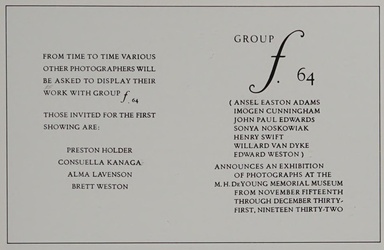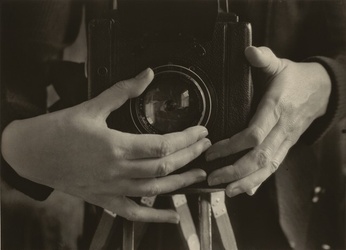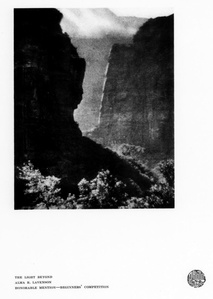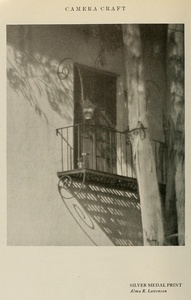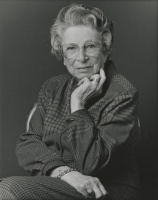 Alma LavensonAlma Ruth Lavenson (May 20, 1897 - September 19, 1989) was a photographer renowned for her studies of Western landscapes, as well as industrial and urban subject matter.
Alma LavensonAlma Ruth Lavenson (May 20, 1897 - September 19, 1989) was a photographer renowned for her studies of Western landscapes, as well as industrial and urban subject matter.
Born in San Francisco, Lavenson moved with her family to Oakland after the 1906 earthquake and fire. She majored in psychology at the University of California in Berkeley. An interest in amateur photography Lavenson developed using a Kodak camera grew over the years into a career. The first publication of her photos was of Zion Canyon, called "The Light Beyond". It appeared on in the November 1927 issue of Photo-Era magazine, 3 then it was printed on the cover of the December 1927 issue the following month. 2
Lavenson branched out into landscapes, portraits and architectural subjects. In 1929, Lavenson continued her work by expanding into industrial and urban photography, exploring abstract shapes and patterns.
She worked with and was close friends with Ansel Adams, Imogen Cunningham, Edward Weston, and other members of the Group f.64, along with other photographic masters of the period. 2 In 1932, she and a select few others were invited by Group f.64 to joint an exhibit at the De Young Museum in San Francisco.
Many of Lavenson’s photographs are available at the Bancroft Library, UC Berkeley, through their Online Archive of California. Their description of the collection follows:
“The California Gold Rush Mining Towns collection contains 373 photographs taken between 1930 and 1968 by Alma Lavenson. The collection consists of views of several of the towns and camps of the Mother Lode region — the area located roughly between Georgetown and Mariposa — which was heavily mined for its great quantities of gold-bearing quartz. Approximately 60 communities which originally developed during the Gold Rush period following 1848 are represented in the collection. Many of these communities were apparently nearly abandoned by the time of Lavenson’s visits. The towns range from more well-known areas such as Nevada City, Grass Valley, Columbia, North San Juan and Coloma, to smaller, more obscure areas such as Rough and Ready, Copperopolis, Goodyear’s Bar, Fiddletown and Timbuctoo. Especially featured in the collection are Gold-Rush-era structures such as hotels, residences, stores, restaurants, banks, churches, post offices, and jails, as well as cemeteries, farms and mining developments. Many street scenes feature storefront architecture remaining from the Gold Rush period.” 1
 Spiral, Tomar, Portugal, 1962
Spiral, Tomar, Portugal, 1962 California Gold Rush Mining graveyard
California Gold Rush Mining graveyard
Oakland connections
- Alma's father Albert S. Lavenson worked for The Lace House, which later became H. C. Capwell's.
- In 1910, Alma and her cousin Amy Dinkelspiel were in Rabbi Friedlander's confirmation class at the First Hebrew Congregation (Temple Sinai). See SF Call, 25 November 1910
- In 1911, Alma finished her grammar school studies from the Horton School, a small school run by Miss Sarah W. Horton, near the corner of 12th Street and Filbert. See SF Call, 25 May 1911
- In 1920, Alma lived with her parents at 657 Walsworth Avenue, along with a cook and a maid. The name Walsworth Avenue no longer exists, but the address is now 3921 Harrison St.
- September 6, 1933, she married Mattheais Wahrhaftig, a young attorney. Matt was a boarder at 423 Elwood Avenue, not far from her parents' home.
- Alma and Matt are buried in the Lavenson plot at Home of Eternity Cemetery.
 Alma Lavenson Wahrhaftig grave marker
Alma Lavenson Wahrhaftig grave marker
photo from Our Oakland
Links and References
- California Gold Rush Mining Towns Photographed by Alma Lavenson, 1930-1968
-
Alma Lavenson Wikipedia
-
Photo-era Magazine November 1927
-
Camera Craft Magazine October 1929
-
Self-Portrait, 1932 National Gallery of Art
-
Alma Lavenson: Mother Lode Photographs California Historical Society Quarterly Summer 1999


